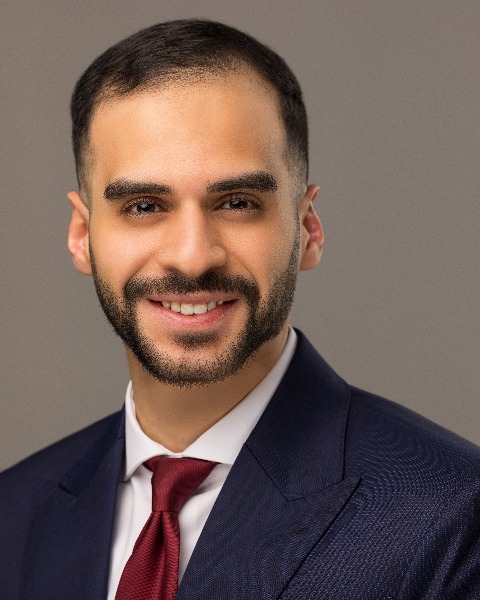Sunday Poster Session
Category: Liver
P1842 - Late Hepatic Venous Outflow Obstruction Post Deceased Donor Liver Transplant Managed With Balloon Angioplasty: A Case Report
Sunday, October 26, 2025
3:30 PM - 7:00 PM PDT
Location: Exhibit Hall

Hisham Habib, MD
Beth Israel Lahey Health
Burlington, MA
Presenting Author(s)
Hisham Habib, MD, Ishan Antony, MD
Beth Israel Lahey Health, Burlington, MA
Introduction: Hepatic venous outflow obstruction (HVOO) is a rare complication of piggyback orthotopic liver transplant (OLT), which involves preservation of the recipient's IVC. Most cases of HVOO described in the literature present early following transplantation with a median of 26 days post-transplant. The incidence of late HVOO, occurring after more than one-year post-transplant, is below 1% in large case series. We report this case of HVOO that occurred two years following piggyback OLT, managed with balloon angioplasty. This case may provide insight on the durability of balloon-only therapy, potentially avoiding more invasive interventions.
Case Description/
Methods: This is a 61 year old female who underwent piggyback OLT for decompensated cirrhosis with no immediate post-operative complications who presented with worsening abdominal ascites two years following transplant. Her labs on presentation were significant for total serum bilirubin of 2, INR of 1.4, transaminases within normal limits, and tacrolimus trough of 8 ng/mL. An ultrasound (US) of the abdomen revealed moderate abdominal ascites with hepatofugal flow in the portal vasculature with a peak velocity of 22.6 cm/s. Fluid analysis including a serum ascites albumin gradient (SAAG) of > 1.3 g/dL. A CT of the abdomen and pelvis was inconclusive with artifact within the portal vasculature. She subsequently underwent inferior vena cava (IVC) and hepatic vein (HV) venograms which demonstrated complete occlusion at the site of the IVC-HV anastomosis with reversed flow into collaterals, with patent hepatic and portal veins. Hepatic venous pressure gradient was elevated at 10 mmHg. Transjugular liver biopsy revealed findings of outflow tract impediment, with no evidence of rejection. Repeated balloon angioplasty resulted in improvement of flow and pressure gradients to below 5 mmHg following two procedures. The patient's ascites had resolved following interventions within three months, with no recurrence within a six-month follow up period. Repeat US imaging with Doppler demonstrated hepatopetal flow within the portal vasculature.
Discussion: The number of reported cases of late HVOO appears to be less than than 20. Recurrence of ascites post OLT with inconclusive non-invasive imaging should prompt early venography for precise anatomical delineation. Repeated balloon angioplasty appears to be a viable management option for post-transplant HVOO at the site of IVC-HV anastomosis, and can avoid stenting, surgical revision and re-transplantation.
Disclosures:
Hisham Habib indicated no relevant financial relationships.
Ishan Antony indicated no relevant financial relationships.
Hisham Habib, MD, Ishan Antony, MD. P1842 - Late Hepatic Venous Outflow Obstruction Post Deceased Donor Liver Transplant Managed With Balloon Angioplasty: A Case Report, ACG 2025 Annual Scientific Meeting Abstracts. Phoenix, AZ: American College of Gastroenterology.
Beth Israel Lahey Health, Burlington, MA
Introduction: Hepatic venous outflow obstruction (HVOO) is a rare complication of piggyback orthotopic liver transplant (OLT), which involves preservation of the recipient's IVC. Most cases of HVOO described in the literature present early following transplantation with a median of 26 days post-transplant. The incidence of late HVOO, occurring after more than one-year post-transplant, is below 1% in large case series. We report this case of HVOO that occurred two years following piggyback OLT, managed with balloon angioplasty. This case may provide insight on the durability of balloon-only therapy, potentially avoiding more invasive interventions.
Case Description/
Methods: This is a 61 year old female who underwent piggyback OLT for decompensated cirrhosis with no immediate post-operative complications who presented with worsening abdominal ascites two years following transplant. Her labs on presentation were significant for total serum bilirubin of 2, INR of 1.4, transaminases within normal limits, and tacrolimus trough of 8 ng/mL. An ultrasound (US) of the abdomen revealed moderate abdominal ascites with hepatofugal flow in the portal vasculature with a peak velocity of 22.6 cm/s. Fluid analysis including a serum ascites albumin gradient (SAAG) of > 1.3 g/dL. A CT of the abdomen and pelvis was inconclusive with artifact within the portal vasculature. She subsequently underwent inferior vena cava (IVC) and hepatic vein (HV) venograms which demonstrated complete occlusion at the site of the IVC-HV anastomosis with reversed flow into collaterals, with patent hepatic and portal veins. Hepatic venous pressure gradient was elevated at 10 mmHg. Transjugular liver biopsy revealed findings of outflow tract impediment, with no evidence of rejection. Repeated balloon angioplasty resulted in improvement of flow and pressure gradients to below 5 mmHg following two procedures. The patient's ascites had resolved following interventions within three months, with no recurrence within a six-month follow up period. Repeat US imaging with Doppler demonstrated hepatopetal flow within the portal vasculature.
Discussion: The number of reported cases of late HVOO appears to be less than than 20. Recurrence of ascites post OLT with inconclusive non-invasive imaging should prompt early venography for precise anatomical delineation. Repeated balloon angioplasty appears to be a viable management option for post-transplant HVOO at the site of IVC-HV anastomosis, and can avoid stenting, surgical revision and re-transplantation.
Disclosures:
Hisham Habib indicated no relevant financial relationships.
Ishan Antony indicated no relevant financial relationships.
Hisham Habib, MD, Ishan Antony, MD. P1842 - Late Hepatic Venous Outflow Obstruction Post Deceased Donor Liver Transplant Managed With Balloon Angioplasty: A Case Report, ACG 2025 Annual Scientific Meeting Abstracts. Phoenix, AZ: American College of Gastroenterology.
